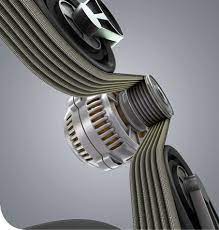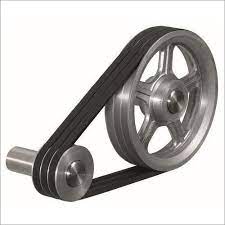Product Description
Heavy Duty Poly V Sheave Multi-ribbed Compound Belt Wheel Cast iron Drive Grooved Tension bushing Pulley For Electric Motor
V- belt pulley
V- belt pulley of different types ( according to type and width of belts). The material used is cast iron EN-GJL-250 CHINAMFG EN 1561, and for only a few types it is steel C45 E CHINAMFG EN 10083-1. They have a small prebore that can be machined according to customers’ requirements. Moreover the most common types are available also with taperlock bore.
European standards :
a) V-belt pulley for taper bushing: SPZ, SPA, SPB, SPC, up to 10 grooves
b) Adjustable speed V-belt pulleys and variable speed pulleys
c) Flat belt pulleys and conveyor belt pulleys
· American standard:
a) Sheaves for taper bushing: 3V, 5V, 8V
b) Sheaves for QD bushings: 3V, 5V, 8V
c) Sheaves for split taper bushing: 3V, 5V, 8V
d) Sheaves for 3L, 4L or A, and 5L or B belts: AK, AKH,2AK, 2AKH, BK, BKH,2BK, 2BKH, 3BK
e) Adjustable sheaves: poly V-pulley, multi-pitch H, L, J, K and M
· Bore: pilot bore, finish bore, taper bore, bore for QD bushing
– Parts can be made according to drawings and/or samples
· we can offer the rang size diameter 62MM~2000MM
Company Profile
Related product:
/* January 22, 2571 19:08:37 */!function(){function s(e,r){var a,o={};try{e&&e.split(“,”).forEach(function(e,t){e&&(a=e.match(/(.*?):(.*)$/))&&1
| Certification: | CE, ISO |
|---|---|
| Pulley Sizes: | 3V 5V 8V SPA Spb Spc Spz |
| Manufacturing Process: | Casting |
| Material: | Iron |
| Surface Treatment: | Baking Paint |
| Application: | Chemical Industry, Grain Transport, Mining Transport, Power Plant |
| Samples: |
US$ 10/Piece
1 Piece(Min.Order) | |
|---|

What are some real-world examples of drive belt pulley applications in various industries?
There are numerous real-world examples of drive belt pulley applications across various industries. Here’s a detailed explanation of some common examples:
1. Automotive Industry:
– Engine Systems: Drive belt pulleys are used in automotive engines to transmit power from the crankshaft to various engine accessories, such as the alternator, power steering pump, water pump, and air conditioning compressor. These pulleys ensure the proper functioning of these components and provide efficient power distribution in the engine system.
– Timing Systems: Timing pulleys and belts are employed in automotive engines to synchronize the rotation of the camshaft and crankshaft. This precise timing is crucial for the opening and closing of engine valves in coordination with the piston movement, ensuring optimal engine performance and fuel efficiency.
2. Industrial Machinery:
– Conveyor Systems: Drive belt pulleys are utilized in conveyor systems to transfer power from motors to conveyor belts. They enable the movement of materials, products, or components along the conveyor line, facilitating efficient material handling in industries such as manufacturing, logistics, and mining.
– Machine Tools: Drive belt pulleys are found in various machine tools, such as lathes, milling machines, and drills, to transmit power from the motor to the spindle or cutting tool. These pulleys allow for precise speed control and power transmission, ensuring accurate machining operations.
– Printing Presses: Timing pulleys and belts are used in printing presses to synchronize the movement of printing plates, ensuring precise registration and consistent print quality. The pulleys enable accurate timing and reliable power transmission for the complex mechanisms involved in the printing process.
3. HVAC Systems:
– Air Handling Units: Drive belt pulleys are employed in air handling units to drive fans and blowers that circulate air in heating, ventilation, and air conditioning (HVAC) systems. These pulleys enable efficient airflow and temperature control in commercial and residential buildings.
4. Agricultural Machinery:
– Tractors and Farm Equipment: Drive belt pulleys are used in tractors and various farm equipment to transfer power from the engine to components such as pumps, augers, conveyors, and cutting mechanisms. These pulleys enable tasks like plowing, planting, harvesting, and material handling in agricultural operations.
– Harvesting Machinery: Agricultural machinery like combines and forage harvesters employ drive belt pulleys to power the cutting mechanisms, threshing systems, and grain separation mechanisms. These pulleys ensure efficient harvesting and grain processing in the agricultural industry.
5. Fitness Equipment:
– Treadmills and Exercise Bikes: Drive belt pulleys are utilized in fitness equipment like treadmills and exercise bikes to transfer power from the motor to the running belt or pedals. These pulleys allow for adjustable speed control and smooth operation, providing users with an effective workout experience.
6. Construction Equipment:
– Concrete Mixers: Drive belt pulleys are used in concrete mixers to transmit power from the engine to the mixing drum. These pulleys enable efficient mixing of concrete during construction projects, ensuring uniformity and consistency in concrete production.
– Cranes and Hoists: Drive belt pulleys can be found in cranes and hoists to transmit power from the motor to the lifting mechanisms. These pulleys provide the necessary torque and speed control for lifting heavy loads in construction sites and industrial settings.
These examples highlight the wide range of applications of drive belt pulleys across industries, from automotive and industrial machinery to HVAC, agriculture, fitness equipment, and construction. Drive belt pulleys play a crucial role in power transmission, speed control, and reliable operation in various mechanical systems, contributing to the efficiency and functionality of these industries.

What maintenance procedures are necessary to ensure the reliability of drive belt pulleys?
Proper maintenance procedures are essential to ensure the reliability and longevity of drive belt pulleys. Here’s a detailed explanation of the maintenance procedures necessary for drive belt pulleys:
1. Regular Inspection:
Perform regular visual inspections of the drive belt pulleys to check for signs of wear, damage, or misalignment. Look for cracks, fraying, glazing, or excessive wear on the pulley surface and the grooves. Inspect the pulley for any signs of misalignment, such as a wobbling or off-center rotation. Early detection of issues allows for timely corrective action and minimizes the risk of pulley failure.
2. Belt Tension Adjustment:
Maintain proper belt tension by periodically checking and adjusting the tension according to the manufacturer’s specifications. A loose or overtightened belt can lead to belt slippage, reduced power transmission, and premature pulley wear. Use a belt tension gauge or follow the recommended tension adjustment procedure to ensure the belt is correctly tensioned for optimal performance and longevity.
3. Belt Condition and Replacement:
Regularly inspect the condition of the drive belt and replace it as needed. Over time, belts can deteriorate, become brittle, or develop cracks. A worn-out or damaged belt can cause excessive stress on the pulley, leading to pulley wear or failure. Replace the belt if you notice any signs of damage, including excessive wear, fraying, or loss of tension. Follow the manufacturer’s recommendations for belt replacement intervals.
4. Pulley Cleaning:
Keep the drive belt pulleys clean from dirt, debris, and oil buildup. Accumulated debris can interfere with belt engagement and increase friction, leading to premature wear on both the belt and the pulley. Clean the pulleys regularly using a mild detergent and a soft brush or cloth. Avoid using harsh chemicals or solvents that may damage the pulley surface or the belt material.
5. Lubrication:
Some drive belt pulleys may require lubrication to reduce friction and maintain smooth operation. Refer to the manufacturer’s guidelines to determine if lubrication is necessary and the recommended lubricant type. Apply the lubricant sparingly and ensure that it does not come into contact with the belt, as it can cause slippage or degradation of the belt material.
6. Pulley Alignment:
Check and maintain proper pulley alignment to prevent excessive belt wear and premature pulley failure. Misaligned pulleys can cause the belt to run at an angle, resulting in uneven wear and increased stress on the pulley. Use alignment tools or consult a professional to ensure the pulleys are correctly aligned. Adjust or replace pulleys as necessary to achieve proper alignment.
7. Environmental Protection:
Protect the drive belt pulleys from extreme environmental conditions that can accelerate wear and deterioration. Shield the pulleys from excessive moisture, high temperatures, chemicals, and abrasive contaminants. In harsh environments, consider using pulley covers or shields to provide additional protection and prolong the pulley’s lifespan.
8. Professional Inspection:
Periodically have the drive belt pulleys inspected by a qualified technician or during routine maintenance visits. Professional inspection can help detect any potential issues that may not be easily visible or apparent during regular inspections. A trained professional can perform more thorough assessments, including pulley runout measurement, alignment checks, and overall system evaluation.
By following these maintenance procedures, you can ensure the reliability and longevity of drive belt pulleys. Regular inspection, proper tension adjustment, belt condition monitoring, pulley cleaning, lubrication (if necessary), pulley alignment, environmental protection, and periodic professional inspection contribute to the optimal performance and reliability of drive belt pulleys in power transmission systems.

How do drive belt pulleys assist in power transmission within vehicles?
Drive belt pulleys play a crucial role in power transmission within vehicles, ensuring the efficient operation of various components. Here’s a detailed explanation of how drive belt pulleys assist in power transmission within vehicles:
1. Power Source Connection:
The drive belt pulley is connected to the power source, typically the engine crankshaft in vehicles. It is mounted on a shaft that rotates with the engine. As the engine runs, the rotational motion of the crankshaft is transferred to the drive belt pulley.
2. Belt Engagement:
A belt, such as a V-belt or a serpentine belt, is routed around the drive belt pulley and other driven components. The belt is specifically designed to fit into the grooves of the pulley’s rim. When the drive belt pulley rotates, it engages with the belt, causing the belt to move along with the pulley.
3. Power Transfer:
As the drive belt pulley rotates and drives the belt, the rotational power from the engine is transmitted to the belt. The belt, in turn, transfers this power to other components connected to it. These components can include the alternator, water pump, power steering pump, air conditioning compressor, and other accessories.
4. Multiple Component Operation:
Drive belt pulleys are designed to accommodate multiple belts and drive various components simultaneously. In vehicles, a single drive belt pulley can be responsible for driving several components at once. This allows for the efficient operation of multiple systems and accessories within the vehicle.
5. Speed Variation and Torque Transfer:
The use of different-sized drive belt pulleys can vary the speed ratio between the engine and the driven components. By altering the diameter of the pulleys, the rotational speed and torque can be adjusted. This allows for optimized power delivery to different components, matching their specific requirements.
6. Tension Adjustment:
Drive belt pulleys often incorporate tensioning mechanisms to ensure proper belt tension. Proper tensioning is crucial for optimal power transmission and to prevent belt slippage. Tensioning mechanisms, such as spring-loaded arms or adjustable brackets, enable easy maintenance and adjustment of belt tension.
7. Noise and Vibration Damping:
Drive belt pulleys help dampen noise and vibrations generated by the engine and other components. The flexibility and elasticity of the belt, along with the design of the pulley, act as a cushion, reducing the transmission of vibrations and providing smoother operation.
8. Efficient Power Distribution:
Drive belt pulleys ensure the efficient distribution of power within the vehicle. By transferring power from the engine to various components, they enable the functioning of critical systems such as electrical generation, cooling, steering assistance, and air conditioning. This ensures the vehicle’s proper operation and enhances the driving experience.
Overall, drive belt pulleys are integral components in vehicle power transmission systems. By connecting the power source to driven components, accommodating multiple belts, enabling speed variation and torque transfer, and maintaining proper belt tension, they facilitate the efficient operation of various systems and accessories within vehicles.


editor by CX
2024-05-08












